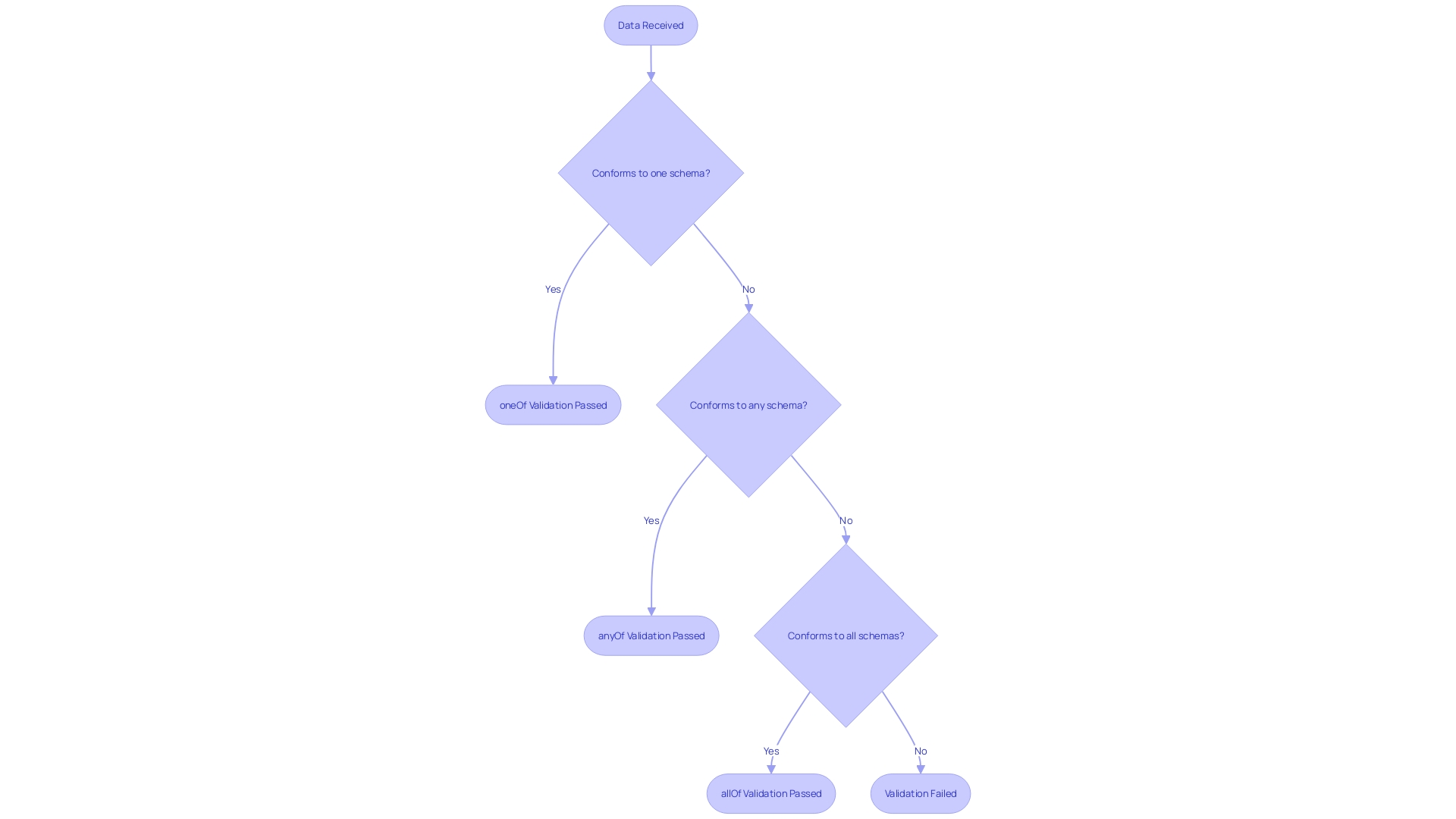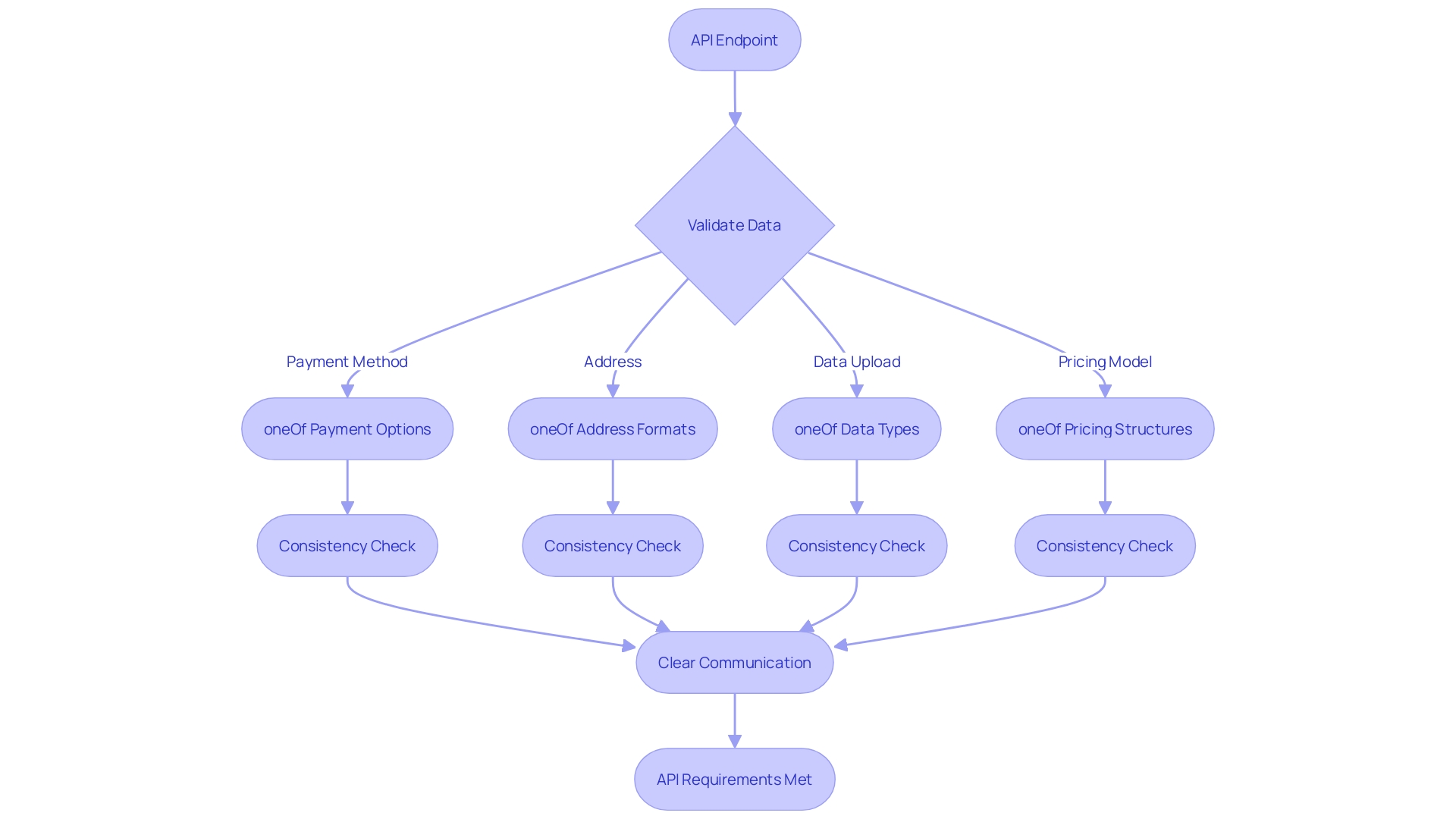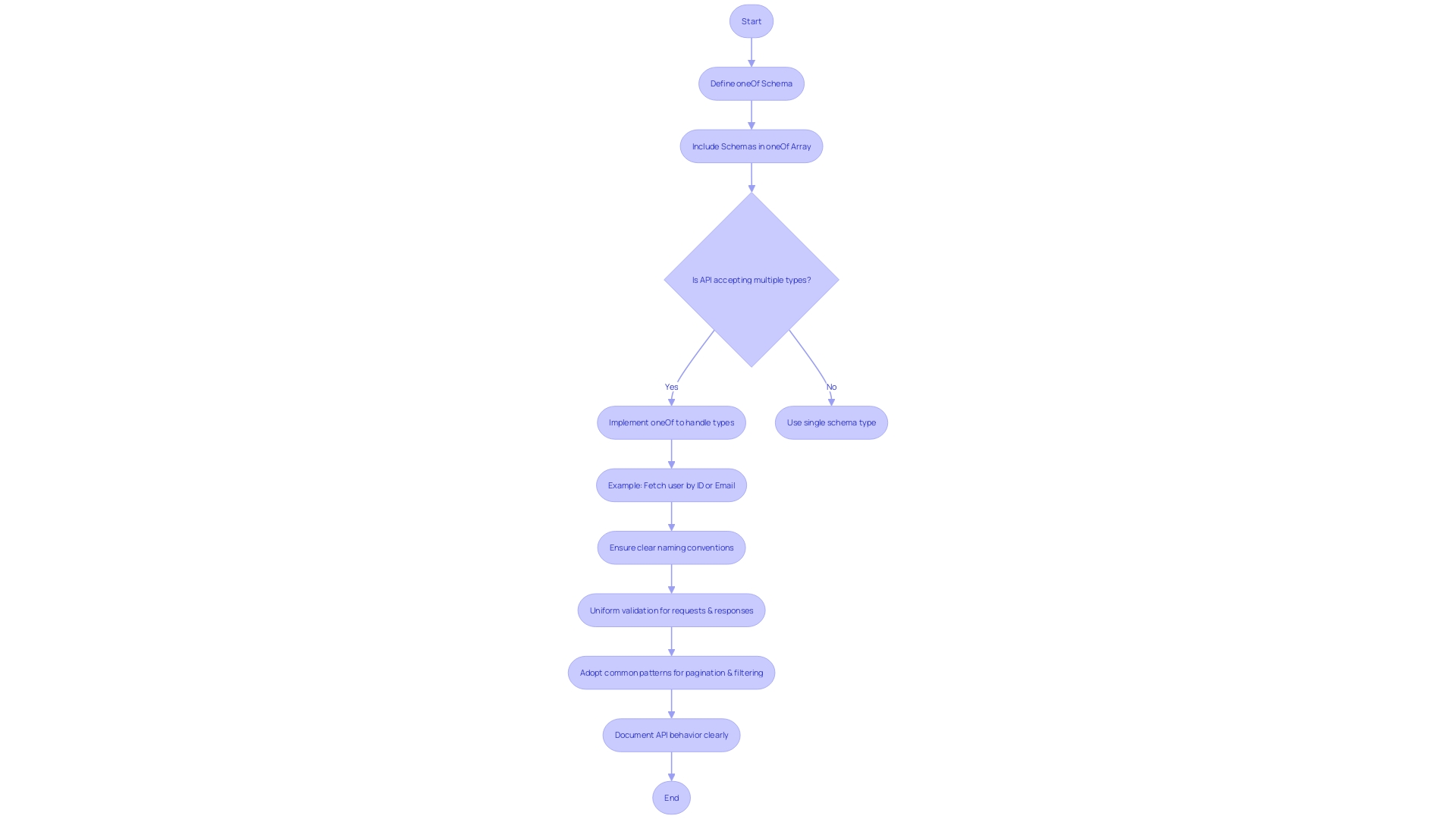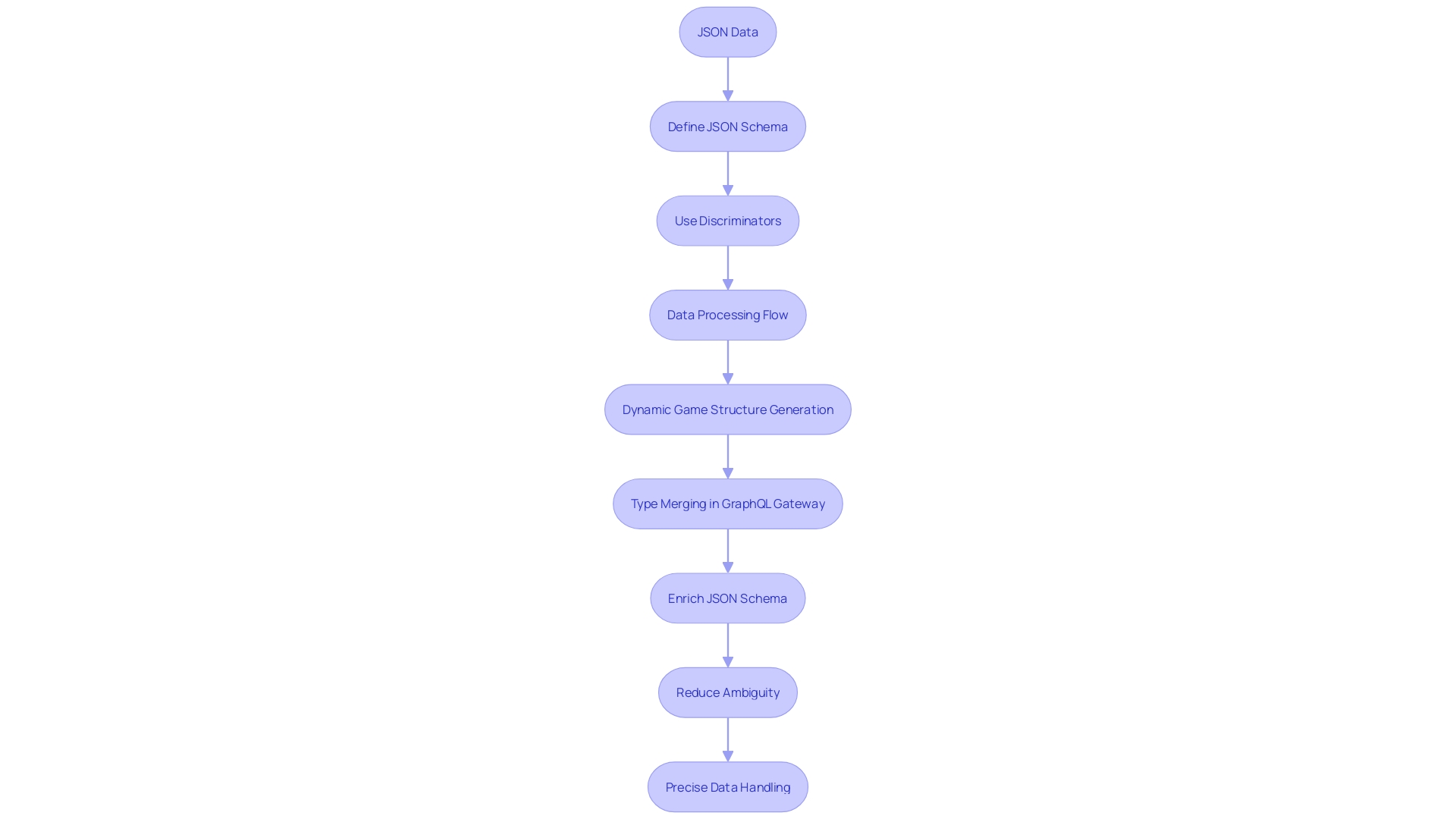Introduction
The oneOf keyword in OpenAPI provides a powerful solution for defining properties that can conform to multiple valid schemas. This feature goes beyond just specifying multiple types; it enables precise validation for inputs, enhancing the robustness and reliability of APIs. With oneOf, developers can ensure that data aligns perfectly with one of several possible structures, no more and no less.
This level of precision is crucial for platforms like GitHub's dynamic documentation system, serving millions of users with diverse data structures. Moreover, the adoption of oneOf aligns with industry trends towards JSON as a standard for data exchange, clarifying data structures and reducing ambiguity. In this article, we will explore the benefits, use cases, and best practices of using oneOf in OpenAPI specifications, as well as its comparison with other keywords like anyOf and allOf.
We will also delve into the mechanics of using oneOf and its practical implementations in real-world scenarios. Finally, we will discuss the use of discriminators with oneOf to enhance data model flexibility, as well as the tools and resources available for working with this powerful keyword. So let's dive in and discover how oneOf can revolutionize your API design and development process.
Understanding the oneOf Keyword
In OpenAPI, the oneOf construct provides a versatile solution for defining a property that can validly conform to exactly one schema out of several possible schemas. This feature is not only about specifying multiple types; it's about enabling refined, logical validation for inputs, thus enhancing the API's robustness and reliability. For example, when an API endpoint accepts a payload where a particular property can be either a string or a complex object, oneOf ensures that the data provided aligns perfectly with one of those structures, no more and no less.
This precision is crucial in situations like GitHub's dynamic documentation platform, where diverse data structures must be accurately documented and validated to serve over 100 million users. It's also a reflection of the API-first design philosophy that champions adaptability and user-centric development, allowing for automation and integration by third parties, as well as internal teams. The adoption of one Of aligns with industry trends towards JSON as a standard for data exchange, which, despite its ubiquity, often requires additional constructs to clarify data structures and reduce ambiguity in data handling.
Use Cases for oneOf
OpenAPI specifications offer a powerful way to define RESTful APIs, including the types of data they can handle. The oneOf keyword exemplifies this flexibility. It allows a single endpoint to accept multiple data formats for a given field, ensuring strict validation against the provided schema.
For instance, a field like 'phone_number' could be designed to receive either a string or an object containing 'country_code' and 'number'. This not only makes the API more versatile but also enhances data integrity, as the API will only accept the data types that are explicitly defined.
Consider the practicality of such a feature in a user registration API for a global platform. With one Of, users from around the world can input their phone numbers in the format most familiar to them, whether that's a simple string or a structured object. This approach aligns with Rest's principles, which emphasize scalable and maintainable design, ensuring that the system remains robust and flexible for future changes and integrations.
Furthermore, GitHub's Docs team, which includes engineers, content writers, and designers, recognizes the importance of clear and precise documentation. Their experience underlines the necessity for APIs to be well-documented, ensuring that developers can easily understand and work with different data structures, including those utilizing oneOf.
As we move towards more interconnected systems, the significance of a versatile and well-defined API interface becomes even more pronounced. JSON, despite being the lingua franca for data exchange on the web, often requires additional specifications to clarify the structure and context of the data being exchanged. one Of addresses this need, allowing for more expressive and less ambiguous data contracts, ultimately facilitating better communication between disparate systems.
Comparison with anyOf and allOf
OpenAPI, a specification for designing and documenting RESTful APIs, includes powerful keywords to shape data validation rules: oneOf, anyOf, and allOf. These keywords manage how data conforms to defined schemas, each serving a unique role in data interpretation.
When using oneOf, the data must align with exactly one of the enumerated schemas. This is akin to a multiple-choice question where only one answer is correct, ensuring that the data adheres strictly to a single expected pattern. For instance, a user's identifier could be defined using one Of to allow either an email or a user ID, but not both.
This precision in data validation caters to scenarios where distinct data structures are acceptable, but they must not overlap.
Alternatively, anyOf loosens these constraints, permitting the data to match one or more schemas. This offers flexibility when diverse data structures are equally valid. An example of anyOf in action could be seen in settings where a user's contact information is required, but it can be provided as either a phone number, an email address, or both.
Lastly, allOf is the most rigid, requiring the data to satisfy all specified schemas simultaneously. This keyword is especially useful when combining multiple schemas to build a composite structure. For example, a product object in an e-commerce application might be required to meet several schemas representing price information, descriptions, and inventory data all at once.
Choosing the correct keyword is vital for ensuring your API's data contracts are clear and effective. Data contracts act as formal agreements on data structure and semantics, and the correct use of these OpenAPI keywords helps maintain integrity and clarity in your API specifications. The adoption of these validation techniques ensures consistency and reduces the potential for errors, making your API more robust and easier to work with.

How to Use oneOf in OpenAPI Definitions
OpenAPI's one Of keyword enhances API flexibility by allowing a field to match one of several provided schemas. This feature becomes particularly valuable when designing APIs with an 'API-design-first' philosophy, where the focus is on creating a programmable interface that puts control into the hands of the end-user. By utilizing oneOf, developers can cater to a variety of user scenarios, making their digital products more adaptable and user-centric.
For instance, imagine an API that needs to handle user data, but the data could be for different types of users, each with a unique data structure. Employing one Of, the API can clearly define these varying user types in its schema, ensuring that the incoming data conforms to one of the predefined structures. This level of precision not only streamlines the validation process but also aligns with the best practices of keeping APIs consistent in their shape and depth, as advocated by experts.
When it comes to the mechanics of oneOf, it's all about consistency and clarity. As stated by professionals, the key is to use the same variable names for similar data, validate the data uniformly across all endpoints, and maintain common parameter patterns. This meticulous attention to detail fosters an environment where emergent use-cases can thrive, supported by an ecosystem of developers and partners who are empowered by well-designed APIs.
Furthermore, in the context of modern software development, where the seamless integration of AI and machine learning outputs into applications is crucial, one can play a pivotal role. It enables controlled generation by dictating the exact format and structure of responses, which is essential for reducing post-processing and ensuring that AI-generated data is immediately usable.
In summary, OpenAPI's oneOf is not just a feature but a cornerstone of an effective API design that respects the journey and experience of the developer. By leveraging one Of, you can build APIs that are not only robust and reliable but also intuitive and conducive to innovation.
Example Implementations of oneOf
OpenAPI's one Of keyword offers powerful flexibility when defining API specifications, allowing for the validation of multiple possible data structures under a single endpoint. For example, when processing payments, the oneOf keyword can accommodate the fact that different payment methods require different sets of data. A credit card payment might need card number, expiry date, and CVV, whereas a bank transfer would require account and routing numbers.
Similarly, for addresses, a US address would differ in structure from an international one, with fields for state and ZIP code rather than province and postal code.
This approach reflects the philosophy of API mechanics, which emphasizes consistency and validation in both requests and responses across all endpoints. By adhering to a standardized pattern for data validation, we avoid the confusion and errors that arise from assumptions or incomplete data descriptions. As JSON, the format typically used in API payloads, is inherently flexible but lacks the ability to self-describe, one Of steps in to provide the necessary structure.
Consider the scenario where an API endpoint must accept data uploads. The ambiguity surrounding the specifics of the data, such as whose details are being uploaded, is resolved using one Of. This ensures clear communication of the API's requirements, leading to fewer inquiries from developers and users alike.
Moreover, the practicality of oneOf extends to pricing models as well. Different products or services might share a single API endpoint but have varying pricing structures. The oneOf keyword allows for distinct price objects to be defined for each scenario, whether it's a monthly subscription, annual fee, or a one-time purchase, thus maintaining clarity and allowing price adjustments without affecting the provisioning system.
As the digital landscape evolves, an API-first design philosophy becomes increasingly significant. It empowers end-users by offering flexibility rather than a fixed interface, enabling the creation of diverse and innovative applications. one Of is integral to this approach, facilitating a dynamic and user-centric API experience.

Common Pitfalls and Best Practices
Mastering the 'oneOf' keyword in OpenAPI specifications requires precise implementation to avoid common mistakes. It's essential to include a comprehensive set of schemas within the 'oneOf' array to cover all possible types your API might accept. This thoroughness ensures consistent and expected validation outcomes, preventing any unforeseen errors during API consumption.
For a practical understanding, consider an API query designed to fetch a user by either id or email. Traditionally, you'd establish separate fields for these identifiers. Yet, with 'oneOf', a single field is sufficient, capable of accepting both identifiers, thus streamlining the process.
The resulting simplicity in the query and the resolver logic not only enhances the API's usability but also maintains a tidy and intuitive structure.
Moreover, implementing 'oneOf' in your API demands strict adherence to a consistent naming convention for variables across all endpoints, which supports the philosophy of a clear and maintainable API design. Every data element must be validated uniformly in both requests and responses, reinforcing the API's reliability. The mechanics of this approach underscore the importance of consistency—whether it's maintaining uniform depth in endpoints or applying common patterns for pagination and filtering.
By incorporating these practices into your API documentation, you provide developers with a clear guide to the expected behavior of 'oneOf' validations. This level of detail in documentation is not just good practice; it's a reflection of an API-first mindset that prioritizes the developer's experience and the versatility of digital products.

Using Discriminators with oneOf
Using discriminators in conjunction with the one Of keyword can significantly enhance data model flexibility, especially in scenarios with complex object hierarchies and polymorphic behaviors. A discriminator is a specific field within a data schema that acts as a switchboard, directing the flow of data processing to the correct type. Consider a gaming application where the structure of a new game—including characters, background stories, and initial player choices—needs to be dynamically generated.
Discriminators enable the application to determine the appropriate object type for a given piece of data, ensuring that each element of the game is correctly interpreted and rendered.
For instance, in a situation where a GraphQL Gateway orchestrates data from separate GraphQL servers—each managing distinct entities such as manufacturers, products, and storefronts—the concept of Type Merging comes into play. This approach treats multiple schemas that define the same type as a singular entity, streamlining the data structure. A discriminator field would then identify the specific type of a merged object, for example, distinguishing between Product and Manufacturer when both are defined across different servers.
This mechanism is not only theoretically elegant but also practically robust. An example from real-world data infrastructure involves Debezium, a tool that has become integral in modern data ecosystems. Debezium exemplifies how a well-structured architecture, including discriminators, can facilitate the seamless flow of data within complex systems.
JSON, as a widely adopted data exchange format, often falls short in scenarios requiring detailed type information. Discriminators, however, enrich the JSON data schema by providing necessary context, reducing ambiguity, and enabling more precise data handling. They serve as a beacon for interpreting data structures, guiding applications to process each data element with accuracy and efficiency.

Tools and Resources for Working with oneOf
Navigating the complexities of the one Of keyword in OpenAPI can be streamlined with the right set of tools. Code generation platforms, such as Kodezi, are instrumental in transforming OpenAPI definitions into usable client libraries and server stubs, thus simplifying the implementation process. Moreover, the ecosystem is enriched with online validators and interactive documentation generators that not only confirm the validity of your oneOf schemas but also enhance the developer experience by providing clear and interactive API documentation.
As JSON has become the quintessential format for data interchange on the web, its limitations in expressing data shapes or contexts can be mitigated with OpenAPI. OpenAPI's capabilities allow for detailed descriptions of possible data structures, reducing ambiguity and improving clarity in communication between services.
In practice, the oneOf keyword shines by offering flexibility in accepting multiple data types for a single field. For example, it supports scenarios where a user might be identified by either an id or an email, as highlighted in the structure below:
{
"userId": {
"oneOf": [
{ "type": "string", "format": "email" },
{ "type": "integer", "format": "int64" }
]
}
}
Here, the userId can be queried using a string representing an email or an integer representing an ID, demonstrating the versatility of OpenAPI in handling polymorphic data types.
In the realm of real-time data analysis, such flexibility is crucial. Platforms like Debezium integrate with data infrastructure stacks to provide timely insights, and OpenAPI specifications play a vital role in ensuring seamless data flow and accurate representation across systems.
As the demand for reliable, modular, and accessible AI ecosystems grows, tools that serve a 'Universal API' become imperative. These tools offer a gateway to a plethora of services under a single endpoint, emphasizing ease of use and freedom for developers. This approach aligns with the trend towards BYOK (Bring Your Own Key) models, where developers can engage with services in a manner that is both accessible and tailored to their specific needs.
With the increasing focus on reliable agents and intelligent search capabilities, analyzing services based on various metrics such as capability, quality, speed, cost, and availability has never been more important. The integration of OpenAPI into such ecosystems ensures that developers have a scalable way to connect with and utilize these services effectively.
Conclusion
The oneOf keyword in OpenAPI is a powerful tool for precise validation of inputs in APIs. It allows properties to conform to multiple valid schemas, ensuring accuracy and reducing ambiguity. By adopting oneOf, developers can build APIs that are robust, reliable, and user-centric.
OpenAPI's oneOf brings flexibility to API design by enabling a single endpoint to accept multiple data formats for a field. This enhances data integrity and aligns with REST principles of scalability and maintainability. Comparing oneOf with other keywords like anyOf and allOf, it becomes clear that choosing the correct keyword is vital for effective data contracts and validation.
To use oneOf effectively, consistency and clarity are key. Uniform validation across endpoints, common parameter patterns, and attention to detail support the emergence of new use-cases. oneOf also plays a crucial role in integrating AI and machine learning outputs, enabling controlled generation and reducing post-processing efforts.
Implementing oneOf requires precision to avoid common pitfalls. Thorough inclusion of schemas and adherence to naming conventions ensure consistent and expected validation outcomes. Incorporating discriminators with oneOf enhances data model flexibility, especially in complex object hierarchies and polymorphic behaviors.
Navigating the complexities of oneOf can be streamlined with the right tools. Code generation platforms like Kodezi simplify implementation, while online validators and interactive documentation generators enhance the developer experience.
In conclusion, OpenAPI's oneOf keyword revolutionizes API design by enhancing precision, flexibility, and data integrity. By leveraging oneOf, developers can build robust, reliable, and user-centric APIs that align with industry trends. With the right tools and best practices, oneOf empowers developers to create innovative applications and deliver exceptional user experiences.
Frequently Asked Questions
What is the oneOf keyword in OpenAPI?
The oneOf keyword in OpenAPI is a construct that allows a property to be validly defined as exactly one schema out of several possible schemas. It enables refined and logical validation for inputs, enhancing the API's robustness and reliability.
How does oneOf improve API flexibility?
oneOf improves API flexibility by allowing a single endpoint to accept multiple data formats for a given field while ensuring strict validation against the provided schema. This makes the API versatile and maintains data integrity.
Can you give an example of how oneOf is used?
Yes, for instance, a 'phone_number' field could be designed to receive either a simple string or an object containing a 'country_code' and 'number'. This allows for different user input formats, which enhances usability on a global platform.
What is the difference between oneOf, anyOf, and allOf?
oneOf requires the data to match exactly one of the defined schemas. anyOf allows the data to match one or more of the schemas, providing more flexibility. allOf requires the data to satisfy all specified schemas simultaneously, creating a composite schema.
How does oneOf contribute to API design philosophy?
oneOf reflects the API-first design philosophy that prioritizes adaptability, user-centric development, and clear documentation. It supports automation and integration by third parties and internal teams, ensuring that APIs are intuitive and conducive to innovation.
What are the benefits of using oneOf in payment processing APIs?
In payment processing, oneOf enables validation of different data sets required by different payment methods, such as credit card details versus bank transfer information, under a single endpoint, which simplifies the API design and user experience.
What are common pitfalls when using oneOf in API specifications?
Common pitfalls include not covering all possible types your API might accept within the oneOf array, leading to unexpected validation errors. It's important to ensure a comprehensive set of schemas and maintain a consistent naming convention across all endpoints.
How do discriminators work with oneOf to enhance data model flexibility?
Discriminators work with oneOf by acting as a field that identifies the type of object being processed, directing the flow of data to the correct schema. This is particularly useful in complex object hierarchies and polymorphic behaviors.
What tools can help with implementing oneOf in OpenAPI?
Tools such as code generation platforms like Kodezi, online validators, and interactive documentation generators can help streamline the implementation of oneOf in OpenAPI. They simplify creating client libraries, server stubs, and provide interactive API documentation.
How does oneOf support modern data infrastructure and real-time analysis?
oneOf allows for the accurate representation of polymorphic data types, which is essential in modern data infrastructure like Debezium for real-time data analysis. It ensures seamless data flow and accurate data representation across systems.




